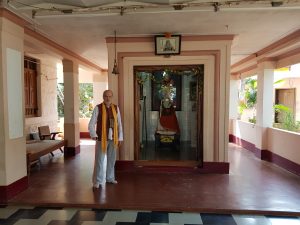Q: About six years ago I was looking for the separate self through directly paying attention to the sense of self in my immediate experience. I did this over about a week or ten days during regular life. I followed this sense of self when it shifted say from the body to the thinking mind, to the sense of will etc. Suddenly everything dropped away and what was seen was just openness/absence of self /no me /nothing +everything.
I’m not sure how long this lasted. Then the mind came back. I felt liberated from all worry and desire for a couple of months. Then slowly old habits reestablished themselves. Since then I am at a loss what to do.
So I have no problem accepting Advaita teachings but I could do with some further guidance.
A: Presumably you are prepared to accept the basic premise of Advaita – that reality is non-dual. If it is true, then it must be the case that you already are the ‘Self’. So it is not really a case of ‘looking for it’ but rather realizing that you are already ‘It’. So you can ask yourself the question ‘who would be looking for what?’. The ‘sense of self’ is not the Self; it is a feeling or an idea in the mind.
If you practice meditation seriously (twice a day, 30mins at a time, for several years), you will eventually experience periods of samAdhi, which correspond to the experience you describe. But this is just an experience – as you can tell because it has a beginning and an end. Realizing the truth of Advaita, becoming ‘enlightened’, is Self-knowledge, not an experience.
Having said that, it is possible to gain Self-knowledge and yet still not have the ‘sense of bliss’, fulfillment or whatever, that you believe ought to result. This is because of ‘obstacles’ in the mind (pratibandha-s) remaining from having insufficiently ‘prepared’ the mind beforehand (sAdhana chatuShTaya sampatti).
The book I am currently writing is all about the confusions that are brought about in seekers as a result of wrong understanding by many modern teachers. pratibandha-s will be one of the topics covered and, because there has been much discussion on related issues at the website recently, I will be begin posting the material for this topic within the next week. It is quite long so will be in 3 or 4 parts. I suggest you look out for it and join in any subsequent discussion if you like. [Since this Q&A, I have posted the pratibandha series, now in around 11 parts, and it begins here.]


 Many misconceptions and misunderstandings appear to be prevailing about Yoga and samAdhi in Advaita. We shall take up in this Part of our Series, an assortment of those topics in no particular order and examine the possible correct position.
Many misconceptions and misunderstandings appear to be prevailing about Yoga and samAdhi in Advaita. We shall take up in this Part of our Series, an assortment of those topics in no particular order and examine the possible correct position. We shall present in this Part – 2 how the word samAdhi is used in Yogavasishta (Yogavasishta is available as a pdf at this site). The word samAdhi occurs very ubiquitously in this text. It is used both in its Yogic and Advaita Vedanta meaning. A few select citations are illustrated below.
We shall present in this Part – 2 how the word samAdhi is used in Yogavasishta (Yogavasishta is available as a pdf at this site). The word samAdhi occurs very ubiquitously in this text. It is used both in its Yogic and Advaita Vedanta meaning. A few select citations are illustrated below.